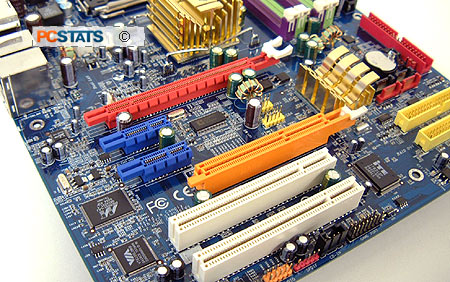
|
Features include a IDE RAID controller, 7.1-channel Intel 'Azalia' audio, four SATA headers, eight USB2.0 ports, and two onboard Ethernet LAN connections.
85% Rating: 
|
|
|
|
Home >
Reviews >
Motherboards >
Albatron PX915P-AGPe |
|
|
PCI Express and AGP?!?
The most
unique feature of the Albatron PX915P-AGPe motherboard is that it has an
AGP socket (in orange below) when the i915P is supposed to be an exclusively PCI
Express chipset, with PCI Express x1 and x16 slots (in blue and red below). Has
Intel gone back on its program to modernize PC's, and do away with legacy
technology like the AGP videocard? Well, no. The orange colour 8X AGP
socket is actually what the industry call an AGP extension socket, and it is
called that because the AGPe runs off the PCI bus. In fact, as far as
the computer is concerned, it is technically the third PCI slot on the
Albatron PX915P-AGPe.

The
benefit of creating a socket 775 motherboard with
an AGPe socket is that is allows consumers to continue to use
their existing AGP videocards, and upgrade to a PCI Express videocard at a later
date, or when they choose to. The downside of AGPe is that it operates on the same
33MHz 33-bit PCI interface, so it does slow down the 3D capabilities of high
performance videocards quite a bit.

Multimedia enthusiasts should be happy to know
that the Albatron PX915P-AGPe is set up so that you can use both a PCI Express and AGP videocard at the same
time. Potentially, that means quad monitors! In our review of the PX915P-AGPe,
we tested out the AGPe socket by running a whole set of 3D benchmarks with a fairly fast 8XAGP Albatron GeForce 6800GT videocard. Those results
are compared to the same benchmarks run with a GeForce
5900 PCI Express videocard.... and we think you'll find the results in the benchmark portion of this review quite interesting.
;-)
Overall I'd say Albatron did a good job with the
PX915P-AGPe motherboard, but things are not perfect. The large ICH6 Southbridge heatsink is very
close to the
AGPe socket, and
that could cause interference with components on the rear of the videocard,
so keep an eye on that when installing. Albatron could have also placed the USB headers in
a better location. Where they are now could potentially interfere with the PCI Express
videocard heatsink if it's a large one.
|
